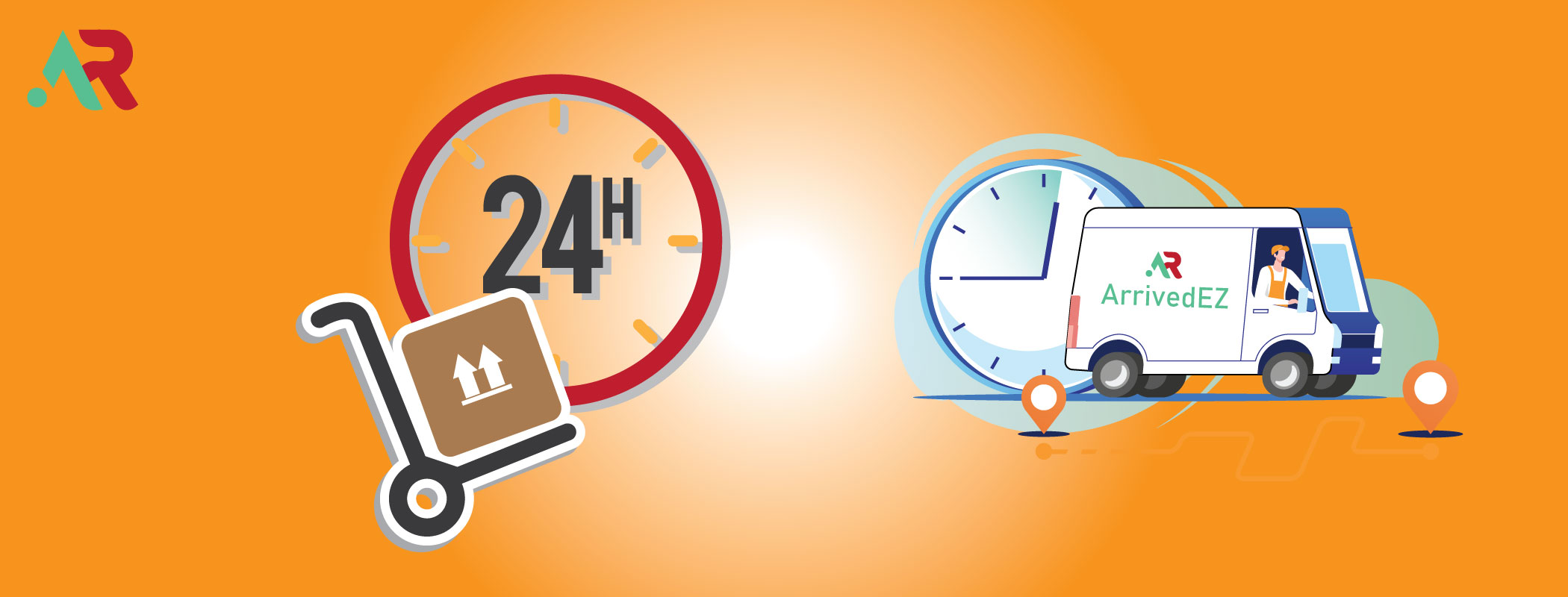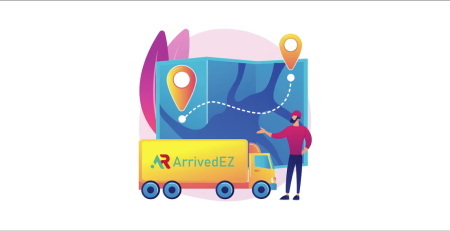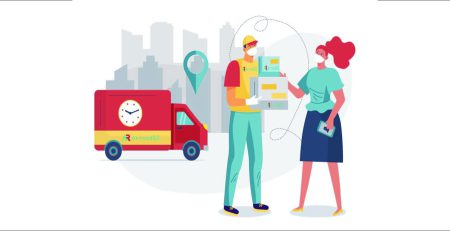The Future of Same-Day Delivery: Navigating Emerging Trends and Predictions
Arrived EZ2023-12-25T14:38:09+00:00In today’s fast-paced world, the demand for convenience and efficiency in the realm of e-commerce has given rise to the evolution of same-day delivery services. As technology continues to advance, the same-day delivery industry is on the cusp of a major transformation. In this blog post, we will explore the upcoming trends and innovations shaping the future of same-day delivery, with a special focus on the role of drones, autonomous vehicles, and other cutting-edge technologies.
Elaborating on Drone Delivery:
Drone delivery has captivated the same-day delivery industry in recent years, providing a glimpse into a future where packages are transported through the air with unprecedented speed and efficiency.

- Revolutionizing the Delivery Process:
Drone delivery services have the potential to revolutionize the entire delivery process. Unlike traditional ground-based methods, drones can navigate through the air, avoiding traffic congestion and delivering packages directly to their destinations. This not only accelerates the delivery timeline but also opens up the possibility of reaching remote or difficult-to-access locations more efficiently.
- Speed and cost-effectiveness:
The key advantage of drone delivery lies in its speed. Drones can cover distances much faster than traditional delivery vehicles, making them particularly well-suited for same-day delivery requirements. This increased speed translates to reduced delivery times, meeting the growing consumer demand for immediacy in online purchases. In addition, businesses anticipate that drone delivery will provide a cost-effective solution with lower operational costs compared to traditional methods.
- Industry Investments and Prototypes:
Major players in the e-commerce and logistics industry have recognized the potential of drone technology and are making significant investments in its development. Companies like Amazon, UPS, and FedEx have already conducted trials and pilot programs to test the feasibility of drone delivery. These initiatives include real-world testing in various locations, helping to refine the technology and address challenges such as safety, navigation, and regulatory compliance.
- Environmental Impact:
Beyond speed and cost-effectiveness, drone delivery offers an environmentally friendly alternative to traditional delivery methods. Drones typically have a smaller carbon footprint compared to traditional vehicles, especially when considering the efficiency gains from direct aerial routes. As the world becomes increasingly conscious of environmental sustainability, the adoption of drone delivery can contribute to the reduction of greenhouse gas emissions associated with last-mile delivery.
Prediction: A Significant Expansion and Environmental Benefits:
Looking ahead, the next few years are poised to witness a significant expansion of drone delivery services. As regulatory frameworks mature, companies will scale up their drone fleets, integrating them into their existing delivery infrastructure. This expansion will not only meet the rising consumer demand for faster deliveries but also contribute to reducing the environmental impact associated with traditional delivery methods.
In conclusion, the rise of drone delivery services represents a paradigm shift in the same-day delivery landscape. The combination of speed, cost-effectiveness, and environmental benefits positions drones as a transformative force in the industry, with the potential to redefine the way we receive packages in the not-too-distant future.
Elaborating on Autonomous Vehicles:
The integration of autonomous vehicles into the same-day delivery sector represents a significant technological leap that promises to redefine the landscape of last-mile logistics.
- Optimizing Routes and Minimizing Human Error:
Autonomous vehicles, ranging from self-driving cars to trucks, bring with them the promise of optimized delivery routes and a reduction in human error. These vehicles rely on sophisticated algorithms and sensors to navigate through traffic, dynamically adjusting routes based on real-time data. Minimizing human involvement in the driving process significantly reduces the potential for errors and delays, contributing to a more reliable and efficient delivery system.
- Operational Cost Reduction:
One of the driving forces behind the adoption of autonomous vehicles in the same-day delivery industry is the potential for operational cost reduction. Unlike human drivers, autonomous vehicles can operate continuously without the need for breaks, resulting in increased productivity and efficiency. Additionally, companies can benefit from savings in labor costs, as the need for human drivers diminishes. These cost advantages contribute to the overall economic viability of integrating autonomous vehicles into delivery fleets.
- Enhancing Efficiency and Reliability:
Autonomous vehicles offer the promise of enhanced efficiency and reliability in same-day deliveries. With the ability to operate 24/7 and adapt to changing traffic conditions, these vehicles can meet the demands of consumers for faster and more predictable delivery times. The use of advanced technologies, such as artificial intelligence and machine learning, allows autonomous vehicles to learn from past experiences, optimizing their performance over time and further improving the reliability of the delivery process.

- Technology and Regulatory Maturation:
As technology continues to advance, and regulatory frameworks adapt to accommodate autonomous vehicles, the industry is poised for a transformative shift. Major technology companies and automotive manufacturers are investing heavily in research and development to refine the capabilities of autonomous vehicles. Simultaneously, governments are working to establish regulations that ensure the safe deployment of these vehicles on public roads. As technology and regulations mature in tandem, governments are gradually overcoming the hurdles to widespread adoption.
Prediction: Autonomous Vehicles as a Staple in Same-Day Delivery:
Looking ahead, the prediction is that autonomous vehicles will become a staple in the same-day delivery industry. As technology matures and gains wider acceptance, companies will increasingly integrate autonomous vehicles into their delivery fleets. Companies will increasingly integrate autonomous vehicles into their delivery fleets, representing a wider, industry-wide transition towards a more autonomous and interconnected fleet, rather than being confined to a few experimental initiatives.
We can anticipate a gradual transition from traditional delivery vehicles to autonomous counterparts, leading to a more streamlined and efficient delivery process. During this transition, we can expect increased reliability, reduced costs, and the ability to meet the evolving demands of consumers for faster and more flexible delivery options.
In conclusion, autonomous vehicles hold immense potential to revolutionize the same-day delivery sector. The combination of optimized routes, reduced human error, operational cost savings, and technological maturation positions autonomous vehicles as a transformative force that will shape the future of last-mile logistics.
- Elaborating on Predictive Analytics and Machine Learning:
In the rapidly evolving landscape of same-day delivery, the role of predictive analytics and machine learning stands out as a crucial element that extends beyond the physical transportation of goods. These technologies are becoming instrumental in transforming the efficiency and precision of logistics operations.

Optimizing Delivery Routes:
Predictive analytics and machine learning algorithms play a pivotal role in optimizing delivery routes. By analyzing historical data, real-time traffic patterns, and various other relevant factors, these technologies can predict the most efficient routes for delivery vehicles. This optimization not only reduces delivery times but also minimizes fuel consumption, contributing to cost savings and environmental sustainability.
- Predicting Demand Patterns:
Understanding and predicting customer demand is essential for same-day delivery services. Predictive analytics, fueled by machine learning, enables companies to analyze vast amounts of data, including past purchase behavior, seasonal trends, and external factors influencing demand. This predictive capability allows businesses to anticipate spikes in demand, adjust inventory levels accordingly, and proactively plan for fluctuations, ensuring that they are well-prepared to meet customer expectations.
- Improving Overall Logistics Efficiency:
Machine learning algorithms excel at identifying patterns and optimizing processes. In the context of same-day delivery, this means improved logistics efficiency. These technologies can analyze data related to warehouse operations, order processing, and inventory management, identifying areas for improvement and streamlining the entire supply chain. The result is a more efficient and responsive logistics network capable of meeting the challenges of same-day delivery.
- Anticipating Customer Needs:
As predictive analytics and machine learning algorithms become more sophisticated, they offer the capability to anticipate customer needs with a high degree of accuracy. By analyzing customer behavior, preferences, and historical data, companies can personalize the delivery experience. This might include suggesting additional items based on past purchases or offering delivery time options tailored to individual preferences, enhancing overall customer satisfaction.
Prediction: Evolving Integration for Enhanced Customer Experience:
Predictive analytics and machine learning will further evolve the integration, enhancing the capabilities of same-day delivery services. This evolution will extend beyond route optimization and demand prediction to include a more holistic approach to customer experience.
Predictive analytics will harness the power to anticipate not only what customers want but also how they want it. This includes optimizing inventory management to ensure that popular items are consistently in stock, refining delivery windows based on individual preferences, and even predicting potential issues in the supply chain before they impact service.
The result will be a same-day delivery experience that is not just fast but also highly personalized and responsive to individual customer needs. Businesses that successfully integrate and leverage predictive analytics and machine learning will have a competitive edge in offering a seamless and satisfying customer experience, setting new standards for efficiency and convenience in the e-commerce landscape.
Elaborating on Collaborative Ecosystems:
As the demands for same-day delivery continue to surge, businesses are recognizing the need for innovative solutions that go beyond traditional models. The rise of collaborative ecosystems is transforming the same-day delivery landscape, fostering partnerships between key players in the industry for more efficient and interconnected delivery networks.
- Partnerships for Seamless Solutions:
Collaborative ecosystems in the context of same-day delivery involve strategic partnerships between retailers, logistics providers, and technology companies. By pooling their expertise, resources, and technologies, these partners aim to create end-to-end solutions that address the complexities of same-day delivery. Retailers bring their product knowledge and customer base, logistics providers contribute their transportation and fulfillment capabilities; and technology companies offer innovative tools for tracking, analytics, and optimization.
- Faster Deliveries Through Synergies:
The primary goal of collaborative ecosystems is to enable faster deliveries by leveraging each partner’s strengths. For example, a retailer might partner with a logistics provider that specializes in last-mile delivery while also integrating cutting-edge tracking and analytics technology from a tech partner. This collaborative approach allows businesses to streamline their operations, reduce redundancies, and overcome logistical challenges, ultimately resulting in quicker and more reliable same-day deliveries.
- Efficiency Through Resource Optimization:
Collaborative ecosystems promote resource optimization by allowing each partner to focus on what they do best. Retailers can concentrate on their core business of selling products, logistics providers can excel in transportation and delivery, and technology companies can contribute innovative solutions to enhance the overall efficiency of the ecosystem. Experts handle each aspect of the delivery process within a collaborative framework, resulting in a more efficient and cost-effective operation.

- Strategic Partnerships for Innovation:
As same-day delivery becomes more integral to the e-commerce landscape, the prediction is that collaborative ecosystems will play an increasingly crucial role in shaping the future of the industry. We can expect to see more strategic partnerships and collaborations that foster innovation and adaptability. These partnerships may extend beyond traditional industry boundaries, with technology companies collaborating with both retailers and logistics providers to create groundbreaking solutions.
Prediction: Shaping an Interconnected Delivery Network:
Experts predict that collaborative ecosystems will evolve into highly interconnected networks that seamlessly connect various stakeholders in the same-day delivery process. These networks will not only optimize the efficiency of existing operations but will also facilitate the adoption of emerging technologies such as drones and autonomous vehicles.
The interconnected nature of these ecosystems will allow for real-time communication, data sharing, and joint problem-solving, creating a dynamic and adaptive delivery network. As a result, businesses operating within collaborative ecosystems will be better positioned to navigate the evolving demands of same-day delivery, providing customers with faster, more reliable, and innovative delivery solutions.
In conclusion, collaborative ecosystems represent a strategic approach to meeting the challenges of same-day delivery. The predicted evolution of these ecosystems points towards a future where partnerships and collaborations are not only common but essential for businesses aiming to deliver an exceptional and competitive same-day delivery experience.
Exciting innovations and technological advancements undoubtedly mark the future of same-day delivery. As drones, autonomous vehicles, predictive analytics, and collaborative ecosystems become integral parts of the industry, customers can look forward to faster, more reliable, and environmentally friendly delivery services. The key to success in this dynamic landscape lies in embracing these emerging trends and staying ahead of the curve, ensuring that same-day delivery remains a cornerstone of modern e-commerce.












Leave a Reply